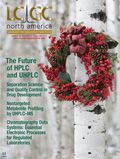Preparing Eluents for HPLC—What You Ought to Know
LCGC North America
A short guide to the do’s, don’ts and gotcha’s of eluent preparation for everyday HPLC
Many of us prepare high performance liquid chromatography (HPLC) eluents every day and can become a little complacent. Here, we present a concise but comprehensive list of do’s and don’ts on eluent preparation from a recent CHROMacademy webcast.
Be sure to use good quality (HPLC-grade) organic solvents and deionized water of at least 18 MΩ resistivity to ensure low levels of background ions (impurities).
Prepare premixed eluents volumetrically by measuring each component separately to avoid an incorrect composition caused by latent heat of mixing effects. To make 1 L of a 50:50 (1:1) mixture of water-acetonitrile, measure 500 mL of water and then separately measure 500 mL of acetonitrile and combine in the eluent reservoir.
If a premixed eluent is to be filtered under vacuum, choose an appropriate filter medium and guard against preferential loss of the more volatile component via selective evaporation under vacuum. Avoid the introduction of air into the eluent via filter paper blockages or gaps between “quickfit” apparatus joints. Also consider if filtration is necessary and if the receiving vessel is free from particulate materials.
Consider the detergents used for washing glassware and their possible adsorption and subsequent desorption from the glassware surface into the eluent mixture, especially when using mass spectrometry (MS) detection.
Degassing eluent systems should be carefully considered, because the in-line degassers in most modern HPLC systems render degassing before use unnecessary. Avoid degassing premixed eluents ultrasonically because the heat generated can often selectively evaporate more-volatile components. If you are using a helium sparge, avoid vigorous bubbling at the eluent surface.
Consider carefully the preparation of buffered mobile phases. A 20 mM formate buffer (pH 2.3) can be prepared as a 20 mM solution of formic acid or ammonium formate adjusted to pH 2.3 using formic acid or another acid. One should be clear about the counterion required for the buffer and the nature of the acid used for pH adjustment to avoid changes in retention and selectivity cause by ionic strength and ion-pairing effects. Also note that in the case of eluents containing 0.1% trifluoroacetic acid, for example, there is virtually no buffering action unless a salt of the acid is also present. One should select a buffer whose pKa is within 1 pH unit of the desired eluent pH.
Be clear about the preparation method required for liquid additives because, depending upon the liquid density, preparing the eluent by weight per volume (w/v) or volume per volume (v/v) can lead to errors. For example, a 0.1% v/v solution of trifluoroacetic acid will not have the same pH as 0.1% w/v trifluoroacetic acid.
The gravimetric measurement and addition of mobile-phase reagents tends to give more accurate and reproducible results than volumetric addition.
When adjusting pH, be aware that a true pH can only be measured in aqueous solution and one should use a properly calibrated pH meter in which the calibrant solution pH values straddle the required pH of the eluent. Also know how to use the pH meter and measuring electrode properly (for example, does the sleeve need to remove from over the filling hole of the electrode?).
If you are stirring the eluent mixture with a magnetic stirrer, stop stirring and allow the eluent liquid to settle before recording the final pH.
When mixing eluent solutions on-line, be sure to include a small amount of aqueous eluent in the organic eluent reservoir and vice versa. While this makes the calculation of composition more complicated, it does avoid effects associated with mixing, dewetting, and cavitation. It also helps to avoid the inadvertent use of 100% aqueous eluents with traditional alkyl bonded phases, which can lead to phase collapse.
Don’t use microbial growth inhibitors such as sodium azide. If absolutely necessary, use a few drops of isopropanol in the aqueous eluent reservoir. However, one should choose sensible expiration dates for eluents to avoid significant microbial growth.
Avoid using laboratory film on eluent reservoirs containing organic solvent. The plasticizers in the film may be leached into the eluent and cause significant background contributions, especially when using MS detection.
Be aware that slowly drifting retention times over a long campaign of analysis can be caused by the evaporation of the more volatile component from a premixed eluent into the increasingly large headspace within the eluent reservoir. Similarly, the pH of aqueous eluent solutions can reduce over time because of the ingress of acidic carbon dioxide.
Get the full tutorial at www.CHROMacademy.com/Essentials (free until January 20).

Determining Enhanced Sensitivity to Odors due to Anxiety-Associated Chemosignals with GC
May 8th 2025Based on their hypothesis that smelling anxiety chemosignals can, like visual anxiety induction, lead to an increase in odor sensitivity, a joint study between the University of Erlangen-Nuremberg (Erlangen, Germany) and the Fraunhofer Institute for Process Engineering and Packaging (Freising, Germany) combined behavioral experiments, odor profile analysis by a trained panel, and instrumental analysis of odorants (gas chromatography-olfactometry) and volatiles (gas chromatography-mass spectrometry).
Investigating 3D-Printable Stationary Phases in Liquid Chromatography
May 7th 20253D printing technology has potential in chromatography, but a major challenge is developing materials with both high porosity and robust mechanical properties. Recently, scientists compared the separation performances of eight different 3D printable stationary phases.
Detecting Hyper-Fast Chromatographic Peaks Using Ion Mobility Spectrometry
May 6th 2025Ion mobility spectrometers can detect trace compounds quickly, though they can face various issues with detecting certain peaks. University of Hannover scientists created a new system for resolving hyper-fast gas chromatography (GC) peaks.

.png&w=3840&q=75)

.png&w=3840&q=75)



.png&w=3840&q=75)



.png&w=3840&q=75)










